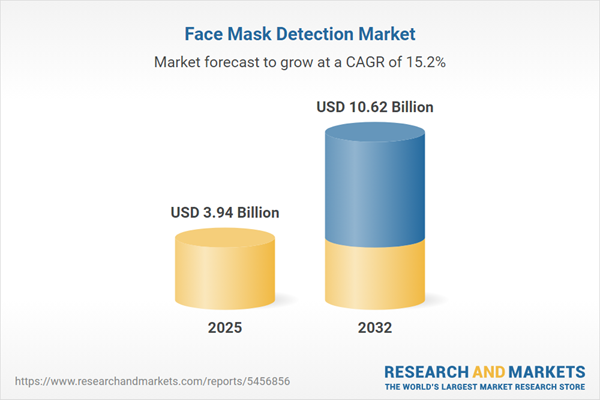Speak directly to the analyst to clarify any post sales queries you may have.
The face mask detection market continues to attract attention as organizations prioritize compliance, operational safety, and technology-driven efficiency. Senior decision-makers are seeking reliable intelligence to anticipate regulatory shifts, navigate regional differences, and harness advancements for strategic advantage.
Market Snapshot: Face Mask Detection Market Size and Growth
The Face Mask Detection Market grew from USD 3.41 billion in 2024 to USD 3.94 billion in 2025. It is expected to continue growing at a CAGR of 15.24% and reach USD 10.62 billion by 2032. This reflects growing global demand for automated compliance solutions across commercial, healthcare, transportation, and public safety domains.
Scope & Segmentation
- Technology
- Laser
- Thermal Imaging
- Ultrasonic
- Visual Based
- 2D Cameras
- 3D Cameras
- Component
- Hardware
- Software
- Deployment Mode
- Cloud Based
- Private Cloud
- Public Cloud
- On Premises
- End User
- Commercial
- Healthcare
- Residential
- Transportation
- Region
- Americas
- North America
- United States
- Canada
- Mexico
- Latin America
- Brazil
- Argentina
- Chile
- Colombia
- Peru
- Europe
- Middle East
- Africa
- Asia-Pacific
- China
- India
- Japan
- Australia
- South Korea
- Indonesia
- Thailand
- Malaysia
- Singapore
- Taiwan
- United Kingdom
- Germany
- France
- Russia
- Italy
- Spain
- Netherlands
- Sweden
- Poland
- Switzerland
- United Arab Emirates
- Saudi Arabia
- Qatar
- Turkey
- Israel
- South Africa
- Nigeria
- Egypt
- Kenya
- Key Companies
- Hangzhou Hikvision Digital Technology Co., Ltd.
- Zhejiang Dahua Technology Co., Ltd.
- Axis Communications AB
- Hanwha Techwin Co., Ltd.
- Robert Bosch GmbH
- Avigilon Corporation
- Honeywell International Inc.
- NEC Corporation
- VIVOTEK Inc.
- Hangzhou Uniview Technologies Co., Ltd.
Key Takeaways
- Rising priorities for health, safety, and compliance are driving a transition from manual monitoring to automated face mask detection solutions within commercial real estate, healthcare, and transportation sectors.
- Artificial intelligence, sensor fusion, and edge computing advancements are enabling real-time detection with improved privacy controls and operational efficiency.
- Market segmentation points to a shift in preference, with cloud-based and on-premises deployments both addressing uniquely stringent data security and latency demands.
- Regional adoption is influenced by differing regulatory mandates, with privacy-centric architectures gaining traction in Europe and technology integration accelerating in Asia-Pacific’s smart city initiatives.
- Top vendors are investing in strategic collaborations—merging hardware and software—to enable modular platforms and flexible deployment models for diverse customer requirements.
Impact of Tariffs on Market Dynamics
Tariff changes, especially in the United States, have increased import costs for key electronic components. This has prompted market participants to diversify supply chains, adjust procurement strategies, and consider nearshoring manufacturing to sustain competitiveness. Closer cooperation among equipment manufacturers and suppliers is facilitating risk-sharing and timely delivery in an evolving global landscape.
Methodology & Data Sources
This report combines primary research, including interviews and targeted surveys with stakeholders, and secondary research across industry documents, patents, and regulatory filings. Rigor is maintained through expert workshops, cross-verification of findings, and scenario-based analysis to ensure trustworthy and actionable insights.
Why This Report Matters
- Identify pivotal trends and emerging technologies shaping the future of the face mask detection market.
- Benchmark strategic options in procurement, deployment, and supplier partnership for sustainable market positioning.
- Gain regional and segment-specific intelligence to inform investment and operational planning.
Conclusion
Ongoing innovation, data-driven strategies, and collaborative approaches will inform market leadership. Use the insights in this report to support resilient and adaptive decision-making in the evolving face mask detection landscape.
Additional Product Information:
- Purchase of this report includes 1 year online access with quarterly updates.
- This report can be updated on request. Please contact our Customer Experience team using the Ask a Question widget on our website.
Table of Contents
3. Executive Summary
4. Market Overview
7. Cumulative Impact of Artificial Intelligence 2025
Companies Mentioned
The companies profiled in this Face Mask Detection market report include:- Hangzhou Hikvision Digital Technology Co., Ltd.
- Zhejiang Dahua Technology Co., Ltd.
- Axis Communications AB
- Hanwha Techwin Co., Ltd.
- Robert Bosch GmbH
- Avigilon Corporation
- Honeywell International Inc.
- NEC Corporation
- VIVOTEK Inc.
- Hangzhou Uniview Technologies Co., Ltd.
Table Information
| Report Attribute | Details |
|---|---|
| No. of Pages | 199 |
| Published | October 2025 |
| Forecast Period | 2025 - 2032 |
| Estimated Market Value ( USD | $ 3.94 Billion |
| Forecasted Market Value ( USD | $ 10.62 Billion |
| Compound Annual Growth Rate | 15.2% |
| Regions Covered | Global |
| No. of Companies Mentioned | 11 |









